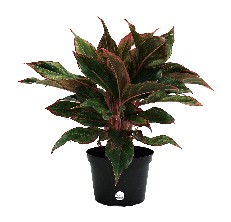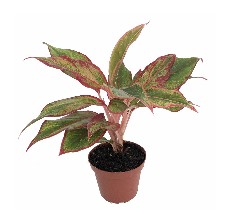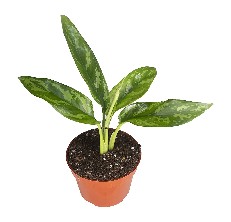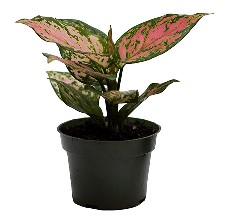- Flowers & PlantsVegetablesOur content is meticulously curated through independent research, testing, reviews, and AI-driven recommendations, all designed to present you with the finest product choices. When you make a purchase through our links, it could result in us earning a commission.
Elevate Your Plant Collection with The Best Chinese Evergreens
 Last updated: Apr 4, 2024
Last updated: Apr 4, 2024The eye-catching Chinese evergreen is a beautiful native Asian plant that is easy to care for and beginner-friendly. In fact, it is almost impossible to kill this plant. This evergreen has become popular for these reasons and comes in many variants. You can choose from solid green variants or patterned variants that are blended with colors such as pink, red, or even yellow. Of course, these variations make sure there is something for everyone’s personality and for every home. So, for especially first-time plant parents, we bring you the top Chinese evergreens in 2024.
The guide below also covers all you need to know about caring for your new plant at home. If you have been a faithful owner of fake plants, it might be time for a change.
Show contentsBest Chinese Evergreens Worth Considering for 2021- Costa Farms Red Chinese Evergreen - Best Overall
- Siam Aurora Chinese Evergreen - Runner Up
- California Tropicals Chinese Evergreen - Honorable Mention
- American Plant Exchange Chinese Evergreen - Contender
Top Chinese Evergreen Buying GuideTop Chinese Evergreen Buying Guide
What Are the Benefits of Chinese Evergreens?
Chinese evergreen plants are widely beneficial. They are not just for show, even though they are lovely and decorative. Because they are so low maintenance, they are a godsend for beginners and those with a brown thumb instead of a green thumb. Also, because they do not need direct sunlight, they are great for individuals who do not have a garden and want natural plants around them.
These plants replenish environmental oxygen just like other plants. Still, another added benefit is that according to a clean air study done by NASA, the Chinese evergreen removes benzene toxins and the formaldehyde compound from the air. This quality further purifies the air you breathe in.
How Do I Prepare Before Buying a Chinese Evergreen?
To be fully prepared for this plant, you need to have a plan even before choosing the Chinese evergreen that is best for you. These are the steps you should take.
Pick a location in your space
Chinese evergreens need to be in low to medium indirect sunlight. They shouldn’t be placed in direct sunlight to avoid scorching the leaves, so you need to consider this. Also, pick a location that will not set your plant directly in front of heating vents or the air conditioning. You should also measure the size of this location in inches to ensure that the plants you pick will fit appropriately.
Consider the colors
A Chinese evergreen can feature different colors ranging commonly from shades of green to pinks, reds, and yellows. Decide on what variant and colors of Chinese evergreen will best suit your space. However, it is no big deal if you cannot decide because these plants are versatile and look good despite the decor. You only need to prioritize your preferences.
Choose a pot
Not all evergreens come in a well-draining pot. Even if the accompanying pot is appropriate, you might want one with a better design. Either way, decide on the pot your plant will be living in before purchase.
Collect your tools and materials
Lastly, before buying a Chinese evergreen, you need to make sure to gather all the supplies you will need. These supplies include planting gloves, proper soil for the plant, shears, and any other things you will need to take care of your plants. We will expand more on the care of Chinese evergreen plants below to help you do this.
How Do I Care For My Chinese Evergreen?
The care of a Chinese evergreen plant is divided into categories, namely, the light, the soil, watering, surrounding humidity and temperature, and the fertilizer needed.
Soil
As we have illustrated, Chinese evergreens are low maintenance, so they are not so selective when it comes to the soil that they are in. For best results, use well-draining soil in a pot with drain holes at the base. If the soil starts retaining too much water, mix in some sand to improve it.
Light
The leaves of your Chinese evergreen are delicate, and so as highlighted above, you should never place them under direct sunlight as this can burn the leaves. The shade of the green color of your Chinese evergreen determines where you place them. It would be best if you put darker green evergreens in the shade. You can place lighter green evergreens in indirect bright light.
Watering
Chinese evergreen thrives best in the balance, not too wet and not too dry. They love moist soil and do poorly in water-logged soil or parched soil. To achieve this balance, water your plants with just enough water and do not water them again until the soil is dried out. Maintain the balance and never let your plant dry out completely.
Fertilizer
Chinese evergreens work best with slow-release fertilizers. These fertilizers customarily come in the form of pellets. You can also use the regular liquid fertilizer but use this sparingly and not more than two times in one year.
Surrounding humidity and temperature
These plants like warm temperatures. Just like with watering, maintain the balance. Not too hot, not too cold. Avoid placing the plant in front of direct heat or cold air from a vent. They also love humidity like greenhouse plants. If you think your plant will need better humidity, you can place your plant in the kitchen or a bathroom.
What Challenges Can I Face With My Chinese Evergreen?
Your Chinese evergreen will be easy to maintain, and you will most likely quickly solve any challenges you will face. Let us look at some of these challenges and their simple solutions.
First, just like any other plant, the evergreen will start to age as the years go by. This occurs more slowly in evergreens but can still happen. If you find an aging leaf, simply cut it off with shears.
You could also encounter burnt leaves if you place the evergreen under direct sunlight. As long as the entire plant is not burned, you can just remove the affected leaves and relocate your plant.
If you have a low humidity environment, you can easily counter this by spraying a mist around your plant.
Concerning watering, whether you over-water or under-water the plant, there is a resolution. Let the topmost one to two inches of soil dry out completely before watering again if you over-water the plant. You can test this by prodding the soil with a small stick. If you under-water the evergreen, remove the dried-out leaves and then slowly water to help the plant recover.
Best Chinese Evergreens Worth Considering for 2021
1Costa Farms Red Chinese Evergreen
– Best OverallIf you are looking to be a first-time plant parent or becoming a new homeowner, the Costa Farms red Chinese evergreen is an excellent choice. This is because it is resistant to drought, easily watered, and can thrive in almost any light condition. It also sports beautiful red edges that bring vibrancy into any room and complement any decor style. As a note, this aglaonema measures approximately 14 inches from the bottom of the pot to the very top of the plant.
Pros- Comes fully rooted in a sturdy black grower’s pot
- Acts as a natural air purifier
- Ships straight from the farm
Cons- Might not be tall enough to place on a floor
2Siam Aurora Chinese Evergreen
– Runner UpThe Siam Aurora Chinese evergreen is the perfect holiday gift. The plant is shipped packaged in the unique Emeritus Gardens way that will be a delight for any relative to receive. The evergreen with its green and pink leaves will always be a fun addition to any room. The plan comes in a 4.5-inch pot filled with loamy soil, but the entire plant measures approximately 20 inches.
Pros- Emeritus Gardens’ slow-release plant food is included
- NASA certified to be air purified
- Easy to care for
Cons- Not suitable for you if you don’t want a plant that will grow slowly
3California Tropicals Chinese Evergreen
– Honorable MentionFor those of you who have a small home office or live in a condo and think you can do better with your decorations and elevate the ambiance of your workspace or home, this tropical evergreen is your salvation. With the California Tropicals Chinese evergreen, what you see is what you get. What you see is a beautiful green plant that easily grows in almost any situation, whether in your accommodation or in the workplace.
Pros- Serves as a great gift
- Is very forgiving, particularly for beginners
- Impressive and secure packaging
Cons- Only suitable for those who want small plants
4American Plant Exchange Chinese Evergreen
– ContenderThe American Plant Exchange Chinese evergreen is another low maintenance option that is also immensely versatile as it is the ideal size to be placed on shelves, on tabletops, and on boards in rooms, homes, offices, or even gardens. The leaves of this evergreen are an appealing rose pink with dark green splashes and borders. You get 4 inches approximately of the air purifying plant and then 7 to 8 inches with the plant pot in total.
Pros- Thrives in low and even artificial light
- Raises humidity in rooms and reduces dryness
- Boosts overall moods and improves sleep
Cons- Not suitable if you want a large plant
Chinese Evergreen FAQ
Q: Are Chinese evergreens safe for pets?A: Not at all. Chinese evergreens contain calcium oxalate, which, if ingested, can be a danger. They do not commonly affect humans but have been toxic to pets, especially dogs and cats. They can cause terrible symptoms for pets, such as difficulty swallowing, drooling, and vomiting. So if you have pets, you have to be careful. Make sure they are not near the plant.
Q: How quickly do Chinese evergreens grow?A: The Chinese evergreen is a slow-growing plant, so it will take years to reach its full height. At their full size, they can grow to be three feet tall with a breadth of about three feet as well. To encourage growth, you should repot your plant once every two years. Since they are slow-growing, you do not have to worry about repotting regularly. If you want to keep the evergreen small, regular pruning should be your go-to.
Q: Are Chinese evergreens the same as dieffenbachias?A: The dieffenbachia and the Chinese evergreen look pretty similar, and so they are quite often mistaken for each other. They are not the same and don’t have similar origins. Luckily, there are some differences to be seen if you look closely enough. Dieffenbachia leaves are much bigger. Chinese evergreens have smaller and more oval leaves.
Q: How can I properly propagate a Chinese evergreen?A: Chinese evergreens can be propagated either through stem cuttings or by splitting the plant while repotting. Warm seasons are the best time to propagate these plants. If you would like to propagate using stem cuttings, make sure you use a cleaned sharp cutting shear to cut a long stem. Coat the bottom of the stem with root hormone and then place it in some water under indirect sunlight. After three to four weeks, roots should form, and you can transfer the plant to a pot and keep it moderately moist. If you would like to propagate by division of the plant, first lay the plant on its side and gently remove it after carefully loosening the soil around it. Shake off the dirt slowly and then gently separate the roots. Then separate a part of the plant to be placed in another pot. Monitor both plants diligently for at least two weeks and keep them moist.
Q: Can a Chinese evergreen carry pests or diseases?A: Pests or diseases are not common occurrences for a Chinese evergreen, but they can happen. If you keep the plant waterlogged for too long, it can lead to fungal diseases such as root rot, and this causes the plant to die. The evergreens can also pick up tiny household pests such as mites, but any of these can be treated with appropriate insecticides.
The Garden Gate Review Team’s product reviews and in-depth guides are here to help you choose the best products for a beautiful and bountiful garden and backyard. The content is created by The Garden Gate Review Team. Garden Gate’s editorial staff is not involved. Garden Gate is reader-supported: When you buy through links on our site, we may earn an affiliate commission. The Garden Gate Review Team is composed of authors, editors, and gardeners. Artificial Intelligence (large language models) may have been used in the research and creation of the content. Please reach out to aimperiapt@gmail.com with any questions regarding product testing or specific articles.



